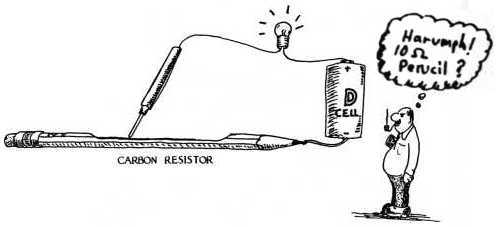
Lots of times, an on/off switch is sufficient, but what if
you'd like to be able to vary the brightness? This is where resistors come in. A
resistor is a component that is meant to be inserted into an electrical path, to
restrict the flow of electricity. To continue the water analogy, a resistor is
very much like a short length of narrow pipe. Most resistors come with two
connecting wires, one at each end, so they can be added to the circuit. There
are also variable resistors such as the volume control on a portable radio, and
they operate much like a water valve or faucet.
The value of a resistor is measured in Ohms, and the higher this value is, the less current will be able to flow through it. When a resistor is inserted into either of the wires that connect a battery to a light bulb, less current is passed and the bulb will be dimmer. By the way, most of the resistors that you will encounter are constructed of some type of carbon material. In high power circuits, thin wire is generally used instead, which is then wound on a ceramic core that won't melt.
